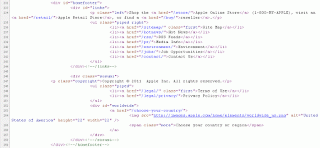Apple.com (Not Really) Updated to HTML5
 Apple has released a revamped version of its web site today, ostensibly in HTML5. Except it doesn’t use anything from HTML5.
Apple has released a revamped version of its web site today, ostensibly in HTML5. Except it doesn’t use anything from HTML5.
That Apple wants to move to the platform that it touts as the Flash-killer is not surprising. Apple refuses to allow Adobe Flash on its mobile devices and claims everything Flash does can be done in HTML5. While not totally accurate, it’s certainly part of Apple’s motivation along with its long-standing claims to support standards. I followed this for a while until it became just senseless bickering:
- Adobe vs. Apple or Flash vs. HTML5, April 12, 2010.
- Adobe to Drop iPhone Support, Target Android, April 21, 2010.
- More Salvos from Apple and Adobe, to No One in Particular, May 13, 2010.
A few very pro-Apple sites have already carried the news about Apple’s new move to HTML5, citing the new look, one even offering a screen shot of the first four lines of the HTML as proof that it’s HTML5.
Except when you look past the first few lines of the code, or really past the DTD which identifies the page using the new minimalist HTML5 DTD, all similarities to HTML5 cease. I’m going to go after the low-hanging fruit here, mostly because I am writing this on a self-imposed deadline. When I opened the source code, I looked for some telltale HTML5 elements, specifically nav, header, footer or canvas (that last one is supposed to be the Flash killer). I found none of them.
Instead I see the standard tag-soup of divs being jammed into roles now replaced with the new semantic and structural elements of HTML5. As an example, this screen shot shows the HTML that drives the footer, all wrapped in nested divs. These could be replaced with the HTML5 footer element.
I understand that browser support is probably the driving concern here. Apple may not want to implement elements that don’t have support in many current browsers. But this half-baked approach, which may be copied by Apple die-hards and HTML5 n00bs alike, does more damage to HTML5 than just leaving the site in HTML4. No, this is a case where prioritizing the marketing message along with ongoing battles with Adobe and now Google are causing Apple’s web development team to fail to implement the specification as it is intended (or will be, when it is final). Which calls into question just how well they will implement any aspect of it, including its attempts to supplant Flash.
But this roll-out wasn’t done with a mountain of HTML5 fanfare. It is possible that I am being too critical, that Apple’s updated site is the first practical step toward future and ongoing implementation of the unique HTML5 elements as the browsers catch up. In that scenario Apple can be forgiven. Except I am not quite so willing to let Apple off that easily given how hard it pushed its HTML5 Showcase back in June. The showcase wasn’t really as much about HTML5 as it was about Safari, and then what CSS3 and JavaScript can do. HTML5 itself didn’t have much of a role in that showcase. It was just a great way to get people to download and use Safari, given that the content was riddled with Safari- and Webkit-specific features. I’m not the only one who takes Apple to task for it (for example, Apple’s HTML5 Showcase Less About Web Standards, More About Apple at Webmonkey). Given Apple’s prior behavior regarding HTML5 (pushing primarily CSS3 and JavaScript) and its motivations (Flash foil, Safari pusher), I’m not so sure Apple is taking the right approach with the new site.
Apple isn’t the only one making this HTML5-but-not-really mistake:
- HTML5 and CSS3 Confusion
- Google, Arcade Fire Confused on HTML5
- Google Doodle: Bouncy Balls Aren’t HTML5
Sadly, we are at a point in time where people are implementing HTML5 the way they implemented HTML4 (as in, poorly). It’s like we just invented the screwdriver but everyone is using it to pound nails.
3 Comments
Does the same HTML get pushed to all browsers or does Safari / weblog get different source?
Oops…meant WebKit.
The same markup gets pushed universally, as far as I can tell. I checked in Chrome, Opera, IE, and Safari (Firefox crashed). I also tried in Lynx, but it seized up, which may have nothing to do with the site.

Leave a Comment or Response